Palacio de Bellas Artes
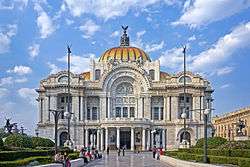
History
The earliest known structure on the site was the Convent of Santa Isabel. Significant Aztec finds, such as a sacrificial altar in the shape of a [ Laws]]. It was replaced it s ur-class housing.[1]
.jpg)
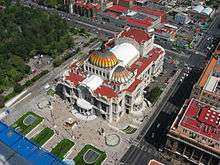
A section of this housing, on Santa Isabel Alley, was torn down and replaced by the National Theater in the latter 19th century. During the late 19th century and very early 20th, this theatre was the site of most of Mexico City's high culture, presenting events such as theatre, operettas, Viennese dance and more. It was then decided to replace this building with a more opulent one for the upcoming Centennial of Mexican Independence celebrations in 1910. The old theatre was demolished in 1901, and the new theatre would be called the Gran Teatro de Ópera. The work was awarded to Italian architect Adamo Boari, who favored neoclassical and art nouveau styles and who is responsible for the Palacio del Correo which is across the street.[1][2] Adamo Boari promised in October 1904 to build grand metallic structure, which at that time only existed in the United States, but not to this size. The first stone of the building was placed by Porfirio Díaz in 1904.[3] Despite the 1910 deadline, by 1913, the building was hardly begun with only a basic shell. One reason for this is that the project became more complicated than anticipated as the heavy building sank into the soft spongy subsoil. The other reason was the political and economic instability that would lead to the Mexican Revolution. Full hostilities suspended construction of the palace completely and Adamo Boari returned to Italy.[1][2]
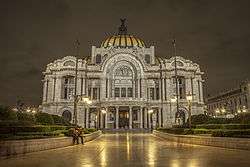
The project would sit unfinished for about twenty years. In 1932, construction resumed under Mexican architect Federico Mariscal. Mariscal completed the interior but updated it from Boari's plans to the more modern Art Deco style. The building was completely finished in 1934,[1][2] and was inaugurated on 29 September of that year.[3] The inaugural work presented in the theatre was "La Verdad Sospechosa" by Juan Ruiz de Alarcón in 1934.[4] In 1946, the Instituto Nacional de Bellas Artes (National Institute of the Fine Arts) was created as a government agency to promote the arts and was initially housed at the Museo Nacional de Artes Plasticas, the Museo del Libro and other places. It is now at the Palacio.[1]
In this theatre, Maria Callas debuted in the opera Norma in 1950.[4]
In 2002, the Palace was the scene of the funeral of María Félix.[4]
Since its initial construction, very little has been updated or modified. However, intensive renovation efforts were begun in 2009 for the upcoming 2010 celebrations.[3] Much of the equipment and machinery is original from the early 20th century. Much of the technological equipment is being updated, especially in the theatre which needs computerized lights, sound systems and other improvements. Other work will improve the acoustics.[5] Upgrades to the theatre will allow for multimedia shows which were not available before.[6] The main hall has had no renovation or upgrade work since it opened in 1934.[5] Renovations here will lessen the number of people the hall can accommodate but should make the area more comfortable.[6]
The building
The palace has a mixture of a number of architectural styles; however, it is principally Art Nouveau and Art Deco.[1] Art Nouveau dominates the exterior, which was done by Adamo Boari, and the inside is dominated by Art Deco, which was completed by Federico Mariscal. Since construction began in 1904, the theater (which opened in 1934) has sunk some four meters into the soft soil of Mexico City.[7] The main facade, which faces Avenida Juárez, is made of white Italian Carrara marble. In the interior of the portal are sculptures by Italian Leonardo Bistolfi. It consists of "Harmony", surrounded by "Pain", "Rage", "Happiness", "Peace" and "Love". Another portion of the facade contains cherubs and sculptures representing music and inspiration.[1] On the plaza front of the building, designed by Boari, there are four Pegasus sculptures which were made by Catalan Agustí Querol Subirats. These had been in the Zocalo before being brought here.[1] The roof covering the center of the building is made of crystal designed by Hungarian Géza Maróti and depicts the muses with Apollo.[3] One aspect of the Palace which has since disappeared is the "Pergola", which was located in the Alameda. It was constructed to house pictorial exhibitions for the 1910 celebrations, but it was demolished in 1973.[1]
The interior is also surfaced in Carrara marble.[3] It divides into three sections: the main hall with adjoining smaller exhibition halls, the theatre and the offices of the Insituto Nacional de Bellas Artes. The main hall is covered by the Marotti glass and iron roof. It and the balconies of all three upper floors can be seen from the ground floor below.[1] In areas of the main hall, pre-Hispanic motifs done in Art Deco style, such as serpents’ heads on window arches and Maya Chaac masks on the vertical light panels distinguish this interior from its contemporaries.[2] The smaller exhibition halls are located on the first and second floors. The first floor is decorated with crystal lamps, created by Edgar Brandt and hold murals by Rufino Tamayo. The Adamo Boari and Manuel M. Ponce halls hold music and literature events. And the National and International halls are for exhibitions. The second floor has smaller exhibition halls as well as murals by José Clemente Orozco, David Alfaro Siqueiros, Diego Rivera, Jorge González Camarena, Roberto Montenegro and Manuel Rodríguez Lozano. The third floor is occupied by the Museum of Architecture. The ironwork was designed in Italy by Alessandro Mazzucotelli and in Mexico by Luis Romero Soto.[1]
At the entrance of the theatre, there are mascarons in bronze with depictions of Tlaloc, and Chaac, the Aztec and Maya deities of water, which along with the rest were designed by Gianette Fiorenzo. On the arch over the stage there are representations of various mythological personas such as the Muses with Apollo. This was constructed in Hungary in the workshops of Géza Maróti.[1] However, the most impacting aspect is the stage "curtain" which is a stained glass foldable panel created out of nearly a million pieces of iridescent colored glass by Tiffany's in New York.[7] This stage curtain is the only one of its type in any opera house in the world and weighs 24 tons.[3] The design of the curtain has the volcanos Popocatépetl and Iztaccíhuatl in the center. Around them is a Mexican landscape surrounded by images of sculptures from Yautepec and Oaxaca. This design was inspired by work done by artist Gerardo Murillo (Dr. Atl).[1][7] The theatre has a capacity of 1,000.[8]
Events
The Palace has been the scene of some of the most notable events in music, dance, theatre, opera and literature and has hosted important exhibitions of painting, sculpture and photography. It has hosted some of the biggest names from both Mexico and abroad. It has hosted poetry events as well as those related to popular culture.[9] Artists and companies are from all parts of Mexico and abroad.[10] It has been called the "Cathedral of Art in Mexico"[9] and is considered to be the most important theatre and the most important cultural center in Mexico. It was declared an artistic monument in 1987 by UNESCO. The building is administered by the Instituto Nacional de Bellas Artes of the federal government.[3] The palace receive on average 10,000 visitors each week.[8]
Two of the best-known groups which regularly perform here are the Ballet Folklórico de México Compania Nacional de Opera de Bellas Artes and the National Symphonic Orchestra.[11] The first performs in the theatre twice a week and is a spectacle of pre and post Hispanic dance of Mexico. A typical program includes Aztec ritual dances, agricultural dances from Jalisco, a fiesta in Veracruz, a wedding celebration — all accompanies by mariachis, marimba players and singers.[2][3] Regular annual events include the Premio Quorum for Mexican designers in graphic and industrial materials[12] and the Premios Ariel for Mexican films.[13]
Individual events that have been held here are numerous. Some of these include several exhibitions of Frida Kahlo's work,[14][15] and a number of appearances by Luciano Pavarotti.[16] In 1987, Bellas Artes hosted a legendary performance of Jesusa Rodríguez's Donna Giovanni, an adaptation of Mozart's opera with a female cast.[17] Other appearances have been made by Mexican baritone Jorge Lagunes (2002)[18] and Catalan guitarist Joan Manuel Serrat (2003).[19] Events that have been held here include "ABCDF Palabras de Ciudad" (2002) showing life in popular housing in photographs and video, "Bordados del Mexico Antiguo" (Embroidery of Old Mexico) showing processes, history and design,[12] Rem Koolhaas Premio Pritzker 2000" conference[20] and "Exchanging Views: Visions of Latin America" which was an exhibit from the collection of Patricia Phelps de Cisneros comprising 148 works by 72 artists from across Latin America in 2006.[21]
Occasionally, the plaza in front of the Palace is the scene of protests such as those against the Iraq War in 2003[22] and against bullfighting in 2010.[23]
Murals

The floors between the ground floor and the uppermost floor are dominated by a number of murals painted by most of the famous names of Mexican muralism.[7]

On the 2nd floor are two early-1950s works by Rufino Tamayo: México de Hoy (Mexico Today) and Nacimiento de la Nacionalidad (Birth of Nationality), a symbolic depiction of the creation of the mestizo (person of mixed indigenous and Spanish ancestry) identity.[2] At the west end of the 3rd floor is El Hombre En El Cruce de Caminos (Man at the Crossroads), originally commissioned for New York's Rockefeller Center in 1933. A giant vacuum sucks up the riches of the earth to feed the factories of card-playing, hard-drinking white capitalist thugs, including John D. Rockefeller himself while workers rally behind the red flag of socialism and its standard-bearer, Lenin. The Rockefellers were not happy with the painting and had it painted over and destroyed. Rivera recreated it here in 1934.[2][7] On the north side of the third floor are David Alfaro Siqueiros' three-part La Nueva Democracía (New Democracy) and Rivera's four-part Carnaval de la Vida Mexicana (Carnival of Mexican Life); to the east is José Clemente Orozco's La Katharsis (Catharsis), depicting the conflict between humankind's 'social' and 'natural' aspects.[2]
Canova's angel statue
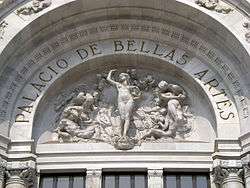
Renowned neoclassical Italian sculptor Antonio Canova had, until early 2015 one of his less noted pieces exhibited in the Palace's Ballet Theater, one of its two theaters. Located directly underneath the cupola aside the National Museum of Architecture, the statue was donated by a private collector in 1902. The statue, a fantastic Neoclassical piece of 3.5 by 2 meters weighed 2.05 tonnes of carved Carrara marble and was admired for Canova's signature technique. Given the enormous size of the sculpture it took over 200 hours of work to install inside the theater overlooking the balconies. The exquisitely detailed masterpiece was yet another sculpture of two angels as is most of Canova's most critically acclaimed work. The statue had often been compared and criticized for its similarity to one of Canova's earlier masterpieces, currently residing in the Musée du Louvre in Paris, Psyche Revived by Cupid's Kiss.
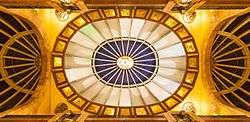
The statue was removed in January 2015 after severe weathering and acidification damage deemed the statue unrecognizable. The statue, once famous for its delicate detail, has been "temporarily replaced with a replica until it has been restored by the world's utmost professionals or replaced by a contemporary art piece" said Miguel Angel Corzo, Mexican-born American arts administrator and Founder and President of the Global Alliance for Conservation, a non-profit organization dedicated to the protection of the world's cultural heritage,a statement released in October of the same year. The real statue has been relocated where every effort to restore it is being made at the University of the Arts (Philadelphia), where Corzo was until 2012 President and CEO. The statue is set to return to its home at the Palace of Bellas Artes in 2018. An investigation concluded in June 2016 by UNESCO world heritage protectors concluded the city's severe pollution problem was responsible for the weathering of the Statue. Given the city's severe pollution problem, "the acidification of the rain is responsible for the change in the pH of the air within the theater" said Corzo, and whilst the same investigation concluded the minor change in the air's pH, particularly during the summer months, the city's most polluted time of the year, was harmless towards humans and it was safe to enter the Palace "it may have reacted with some of the materials the statue was made of resulting in its damage".
"The exact reasons behind the extent of the rapid damage of the acid rain to the sculpture remains a mystery" said Corzo given that the surface of the Palace is made with the same materials the statue was made of: Carrara marble. The statue remained within the palace for little over a century. Precautions had been taken to protect the exterior facade of the Palace in recent years due to the city's increasing pollution problems. "The Palace's facade is treated with abundant chemicals that prevent its weathering every six months, we never thought the pollution would be a problem for the masterpieces within the Palace" Corzo explained.
Some of the Palace's remaining Carrara marble pieces have been relocated where possible in order to prevent further damage. "Preventative treatment for the facade has now been increased to every 4 months in order to limit the damage that the pollution can cause to the Neoclassical wonder that is the Palacio de Bellas Artes" Corzo concluded.
Museo del Palacio de Bellas Artes
The Museo del Palacio de Bellas Artes (Museum of the Palacio de Bellas Artes) is the organization that takes care of the permanent murals and other artwork in the building as well as arrange temporary exhibits. These exhibits cover a wide range of media and feature Mexican and international artists, focusing on classic and contemporary artists.[24]
Museo Nacional de Arquitectura
The Museo Nacional de Arquitectura (Museum of Architecture) occupies the top floor of the building, covered by the glass and iron roof. It contains exhibitions from renowned Mexican architects including models, plans and photographs of major works. This museum also arranges temporary exhibitions of its collections in other facilities. The purpose is to expose the Mexican public to the country's rich architectural heritage. Some of the major architects featured at the museum include Jaime Ortiz Monasterio, Carlos Mijares Bracho, Adamo Boari and Luis Barragán.[25] The museum is divided into four sections called "Arquitectura-contrastes: Jaime Ortiz Monasterio y Carlos Mijares Bracho", "Corpus Urbanístico de la Ciudad de México", "Teatro Nacional de México (Plano original)" and "Teatro Nacional de México."[26] There are also temporary exhibits on contemporary architecture.[2]

References
- 1 2 3 4 5 6 7 8 9 10 11 12 13 "Palacio de Bellas Artes" (in Spanish). Mexico City: Secretary of Tourism of Mexico. 2005-02-07. Archived from the original on 2010-04-08. Retrieved 2010-02-18.
- 1 2 3 4 5 6 7 8 9 "Palacio de Bellas Artes". Lonely Planet Guides. Archived from the original on March 13, 2014. Retrieved February 18, 2010.
- 1 2 3 4 5 6 7 8 "Cumple 75 años el Palacio de Bellas Artes" [Palacio de Bella Artes’ 75th birthday]. Noticias Televisa (in Spanish). Mexico City. Notimex. September 30, 2008. Retrieved 2010-02-18.
- 1 2 3 "Trivia / Historia: El Palacio de Bellas Artes" [Triva/History:The Palace of Bellas Artes]. El Norte (in Spanish). Monterrey, Mexico. 2006-09-27. p. 2.
- 1 2 "Avanza remodelación del Palacio de Bellas Artes" [Remodeling of the Palacio de Bellas Artes advances]. Noticias Televisa (in Spanish). Mexico City. 2009-11-18. Retrieved 2010-02-18.
- 1 2 Sánchez, Luis Carlos (2009-08-17). "Cirugía mayor al Palacio de Bellas Artes" [Major surgery for the Palacio de Bellas Artes]. Excelsior (in Spanish). Mexico City. Retrieved 2010-02-18.
- 1 2 3 4 5 "Museo del Palacio de Bellas Artes". Frommers Guides. Retrieved February 18, 2010.
- 1 2 Garcia, Omar (2003-12-19). "Dan una 'manita' a Bellas Artes" [Giving a small hand to Bellas Artes]. Reforma (in Spanish). Mexico City.
- 1 2 Fox, Vicente (2005-09-29). "El Palacio de Bellas Artes ha sido y seguirá siendo la Catedral del Arte en México" (in Spanish). Office of the President (Mexico). Retrieved 2010-02-18.
- ↑ "Palacio de Bellas Artes". Frommers Guides. Retrieved February 18, 2010.
- ↑ Haw, Dora Luz (2003-08-19). "Escenifican 'Carmen' ante un mayor publico" [Staging Carmen in front of a major audience]. Reforma (in Spanish). Mexico City. p. 4.
- 1 2 Rivas, Angel (2002-05-06). "Enterese" [Get involved]. Reforma (in Spanish). Mexico City. p. 4.
- ↑ "Tienen fiesta de pelicula" [Films have a party]. El Norte (in Spanish). Monterrey, Mexico. 2004-04-01. p. 1.
- ↑ "Inauguran exposicion de Frida Kahlo en Bellas Artes;" [Frida Kahlo exposition inaugurates at Bellas Artes]. Noticias Financieras (in Spanish). Miami. 2004-08-05. p. 1.
- ↑ Malkin, Elisabeth (2007-07-07). "Beyond the Myth, Art Endures". New York Times. New York. Retrieved 2010-02-18.
- ↑ Sanchez, Leticia (1996-12-23). "Pavarotti y mucha opera sonara en Bellas Artes" [Pavarotti and much opera will sound off in Bellas Artes]. Reforma (in Spanish). Mexico City. p. 4.
- ↑ Gutiérrez, Laura G. (2010). Performing Mexicanidad: Vendidas Y Cabareteras on the Transnational Stage. University of Texas Press. p. 77.
- ↑ Cruz, Antimio (2002-10-07). "Se siente Lagunes solido en su trabajo" [Lagunes feels solid about his work]. Reforma (in Spanish). Mexico City. p. 2.
- ↑ Lopez, Sergio Raul (2003-05-09). "Intima Serrat en Bellas Artes" [Serrat give intimate performance at Bellas Artes]. Reforma (in Spanish). Mexico City. p. 22.
- ↑ Buzio, Erika P. (2007-03-03). "Dice Koolhaas alto al mercado". Reforma (in Spanish). Mexico City. p. 8.
- ↑ "Avant-Garde Latin American Art Drawn from Coleccion Patricia Phelps de Cisneros on View at Museo del Palacio de Bellas Artes". Business Wire. New York. 2006-07-26. p. 1.
- ↑ Alvarez, Carmen (2003-03-11). "Construyen con arte un cerco a la guerra" [Constructing with art a fence against war]. Reforma (in Spanish). Mexico City. p. 4.
- ↑ "Protestan frente al Palacio de Bellas Artes contra la tauromaquia" [Protests in front of the Palacio de Bellas Artes against bullfighting]. Excelsior (in Spanish). Mexico City. 2010-02-06. Retrieved 2010-02-18.
- ↑ "Presentación" [Presentation]. Mexico: Instituto Nacional de Bellas Artes. Retrieved 18 February 2016.
- ↑ "Presentación" [Presentation]. Mexico: Instituto Nacional de Bellas Artes. Retrieved February 18, 2010.
- ↑ "Obras representivas" [Representative Works] (in Spanish). Mexico: Instituto Nacional de Bellas Artes. Retrieved February 18, 2010.
External links
| Wikimedia Commons has media related to Palacio de Bellas Artes. |